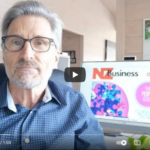The future of meetings
Futurist Dave Wild explains the dynamics of meetings in a hybrid world. How they help business leaders create stronger connections. Throughout time our ability to meet has been central to […]
Futurist Dave Wild explains the dynamics of meetings in a hybrid world. How they help business leaders create stronger connections.
Throughout time our ability to meet has been central to our way of living – to understand complex problems, build stronger relationships and create innovative solutions.
So, if meetings are so pivotal to society, why are they often considered a barrier to progress? To getting things done and focusing on what truly matters?
The problem isn’t meetings. The problem is badly-run meetings.
This isn’t new. We’ve long since known the importance for leaders of meeting facilitation skills. To be able to guide the conversation to achieve effective results. All while managing the difficult balance of maintaining focus without constraining diverse perspectives.
It’s challenging enough to lead a productive, inclusive and engaging meeting when everyone’s in the same room. It’s even more difficult when teams meet online – with the resulting loss in dimensionality of audio and visual clues.
The challenge then steps up another level again in hybrid workplaces, where meetings need to be simultaneously facilitated across a blend of physical and digital spaces.
The future of meetings has arrived.
Meeting in a hybrid world
Online. Virtual. Digital. Distributed. Remote. Hybrid. When societies go through a revolutionary shift, cultures take time to settle on common language to describe new ways of working.
We’ve seen it before. While digital is now a common word to describe the recent industrial revolution, in the early stages of the transformation a wide variety of phrases were used – from ‘the information superhighway’ to ‘ecommerce’.
Once again, as we adapt to change, a range of words are being used to describe the shifting workplace dynamics. Then once these new ways of working are no longer new, the cultural norms can again be shorthanded with a single common word.
Meanwhile, with a remote workforce distributed across locations, at times we meet virtually online, while at other times we come together in-person. Sometimes part of the group is in the room physically, with others in the same group joining digitally.
We’re meeting in a hybrid world.
Meeting strategically
Not all meetings are strategic. Sometimes deliberately so. Other times not.
All too frequently teams set out to have a strategic meeting but become trapped in tactical discussions. So, what goes wrong and how can you shift this?
The answer is in the meaning of the word ‘strategy’.
Paying closer attention to the meaning of everyday words is an under-used development technique. It’s a brilliantly simple way of spotting opportunities and blockers others have missed. Breaking a word down into its component parts is like taking an engine apart – the more you understand how the parts work together to achieve a result, the greater your ability to re-engineer for higher performance.
Strategy means ‘a plan of action to achieve major aims’.
So, when facilitating a strategic meeting, ensure you determine the major aims. Then guide the conversation towards exploring possible actions to achieve.
Refocus the discussion on the major aims when the team gets lost in the detail. And guide out of the abstract towards the tangible when they lose sight of the need to arrive at clear decisions.
Creating the future
We meet to connect, discuss, share, solve, relate, understand, inspire and support.
All involve communication across many different levels.
Some of these levels can now effectively be replicated by other communication means – from phone calls to the written word. Other levels can never be replicated through technology alone. Meaning every leader and organisation now needs to be able to navigate the hybrid world of meetings – adeptly shifting and guiding others across formats and channels, balancing meeting objectives and team needs.
For example, Stanford researchers determined that the default video-call setting of seeing yourself on-screen can increase stress – with studies showing when we see our reflection, we can be more critical of ourselves. Meaning the simple act of facilitating others to adjust camera settings can increase focus and energy while reducing stress.
Creating stronger connections, for a greater future.
Strategic meeting skills
If you’re facilitating strategic meetings in a hybrid workplace, achieve greater outcomes with these expert techniques:
#1 Start before you start
Whether you’re meeting online, offline or both, often not everyone will have arrived by the time your meeting’s scheduled to start. Leading to the inevitable trade-off between starting on time without everyone present, or wasting time waiting.
Frequently people arrive unprepared. Not adequately informed to discuss complex issues that ideally required some preparation or consideration ahead of the meeting.
Avoid frustration by designing a facilitation approach that starts before the meeting starts.
- Think about what you want people to have reflected on prior to meeting.
- Don’t simply send attachments that won’t be read. Avoid time-intensive pre-work. Instead assign a thought-provoking activity that can be undertaken in the flow of work ahead of the meeting.
- For example, ask participants to observe changes and be ready to share a summary word or image. Then use these reflections or another discussion point as an unofficial start as people arrive – sharing perspectives and advancing thinking before turning to the agenda.
#2 Amplify hidden voices
When the answer seems obvious to you – that can be a signal that you have indeed arrived at the best solution. However, it can also signal that you’re blind to greater possibilities that exist beyond the boundaries of your personal perspective and experiences.
Asking questions of your wider team can help shift this.
Remember, more vocal contributors frequently aren’t reflective of the diversity of opinions across the group. So, when facilitating meetings apply a range of techniques to amplify diverse ideas from across the group.
- Recognise that experience is also bias. Otherwise regardless of what people share with you, the risk is you might not hear it.
- Take care to create an environment that doesn’t require introverts to become extroverts to be heard.
- In an in-person environment use techniques such as Post-it noting to get everyone to contribute. It’s not about the note, it’s about the conversation. Ask people to speak to their notes.
- In an online environment use the meeting chat and other collaboration apps to frame questions giving everyone space to respond. People might also miss the question, so type the focusing prompts in the chat.
- When working across a hybrid environment enable those in the room to also contribute to the chat, on mobile devices with cameras and microphones off.
- Use a mix of small breakout groups and times with cameras off to give less extroverted members time and space to form their thoughts.
#3 Create space between
Do you rush from meeting to meeting? Whether you’re physically running down the hall or virtually switching between spaces, the problem isn’t too many meetings. It’s how we’re designing our days.
We all know the theory. Book meeting-free space into your schedule. But all too often these much-needed breaks get hijacked.
So, take advantage of the prevailing psychology of scheduling meetings on the half-hour. Create space between meetings across time-zones.
- Review your scheduled meetings. Adjust one-hour meetings to 45-50 minutes.
- Consider whether a focused 15-25 minutes could lead to the outcomes needed.
- If spending a day together online, limit sessions to 90 minutes with 30-minute breaks between and a re-energising hour for a meal break.
Dave Wild is a futurist living on the edge of the world here in New Zealand. He is the author of the upcoming book and leadership programme ‘Futurework – A Guidebook for The Future of Work’. www.dave-wild.com/futurework





